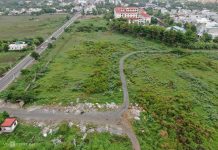A 150-year-old banyan tree in Can Tho City with scores of entangled aerial roots has a matrix-like appearance.
 |
The 10-meter tree at the Gian Gua relic site in Nhon Nghia Ward, Phong Dien District, survived the wars. Its canopy spreads around 3,000 square meters. |
 |
The banyan is part of the mulberry family. The roots of the tree drop from its trunk and branches. Ba Ho, 64, an employee at the relic, said: “The exact number of roots has not been determined but it is for sure more than 1,000. Because of its myriad roots, the tree absorbs enough water and nutrients to sustain itself.” Four groups of people take turns to tend the tree and clean the area. |
 |
The origin of the banyan remains a mystery even to people living here. Many say the tree was already large when they were children, including the relic staff. Many new roots continue to grow from the branches. |
 |
Its main trunks are not gigantic like a typical old tree’s. The biggest only encompasses half an adult’s embrace. |
 |
The twisting branches are intertwined, giving the place an air of mystery. Visitors have to walk on bended knees inside the matrix. The further one goes, the more it feels like a maze. |
 |
The ancient tree is also the first Vietnamese Heritage Tree in the Mekong Delta region, as recognized by the Vietnam Association for Conservation of Nature and Environment. Under its canopy, there used to be revolutionary bases against the French colonial regime and American invaders in the previous centuries. Gian Gua was recognized as a city relic in 2013 by Can Tho City. |
 |
There are two ways to reach the relic. From Can Tho, many tourists take Vong Cung Street, get on the ferry to Nhon Nghia Commune and then ask locals. Another way is to drive down Highway 61B toward Vi Thanh in Hau Giang Province. When you reach the foot of Rach Sung Bridge, turn left and drive until you reach a sign that points to the relic. |
 |
There is no admission fee to enter the relic. Ba Hon said the peak time is usually morning, when many foreign tourists too come. “Vietnamese often come here at noon and late afternoon.” |































